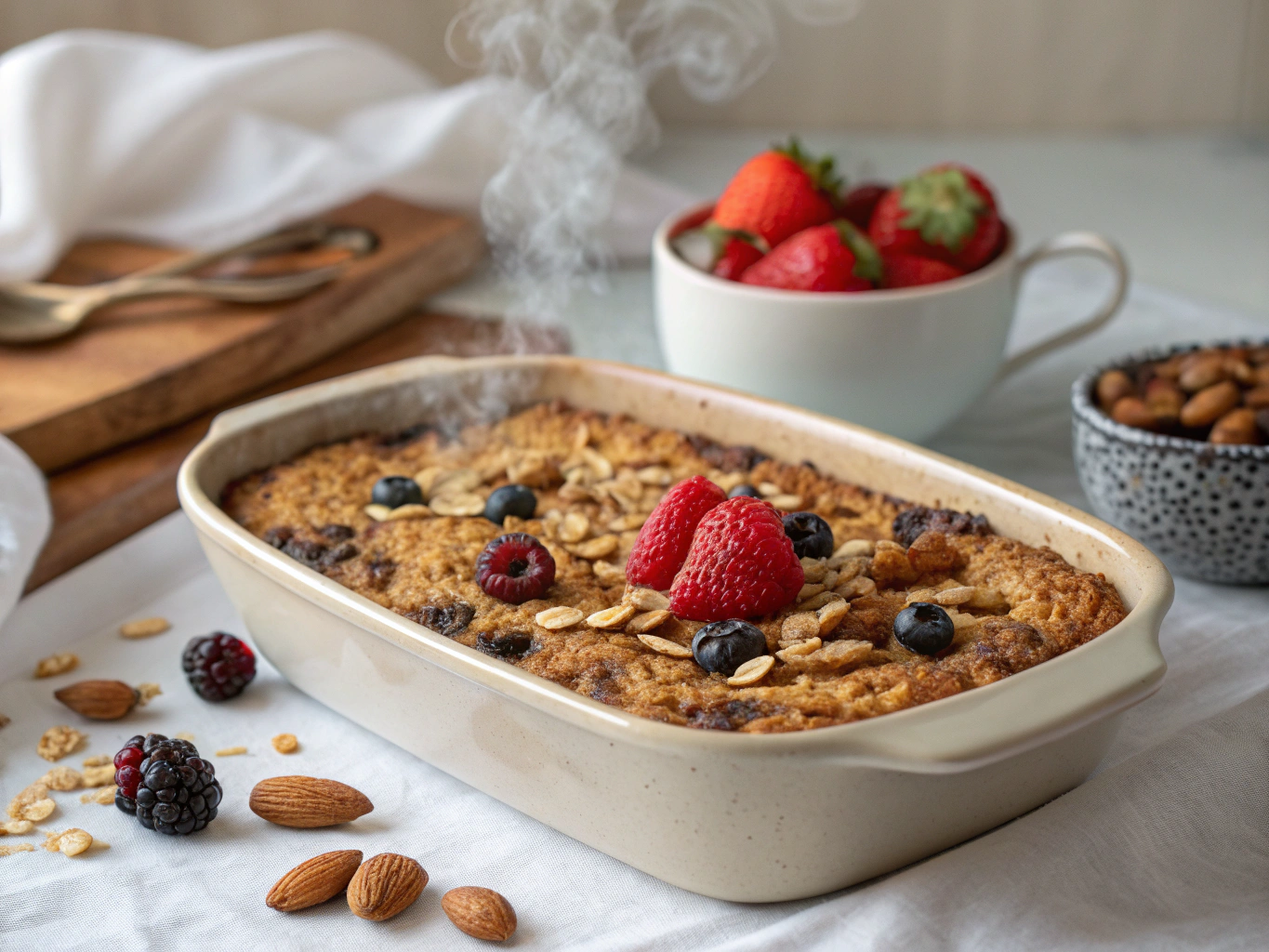
Baked oatmeal combines the hearty goodness of oats with the warm comfort of a casserole. In this article, we’ll dive into its rustic charm and versatility. You’ll discover how to make the ultimate baked oatmeal, plus tips for variations, troubleshooting, and understanding what makes this dish so good for you. We’ll also tap into my Southern roots and share how this recipe’s evolution mirrors the journey of FlavivoRecipes itself—where tradition meets bold new flavor.
Baked Oatmeal and My Southern Kitchen Roots
From Grandma’s Stove to Sunday Brunch Tables
I’m MacMar, a Charleston native raised on slow Sundays scented with cinnamon and warm oats. Baked oatmeal was never just breakfast in our home—it was a cozy gesture, an edible hug. I first learned it watching my grandmother stir oats, brown sugar, and apples together by feel, trusting the scent more than the timer. She baked it in cast iron, and the edges always crisped just right.
Years later, when I ran my first food truck, I reimagined that dish—swapping apple slices for blueberries, playing with coconut milk, folding in spices like cardamom. The result? A version of baked oatmeal that kept the heart of my grandma’s recipe while giving it a fresh spin. That’s how many of my creations start—comfort foods born of memory and touched by curiosity.
Today, at FlavivoRecipes.com, I still turn to baked oatmeal as a go-to. Whether it’s meal prep for the week, a holiday morning treat, or just something warm after a long day, its flexibility keeps it evergreen. Plus, it works with pantry basics—nothing fancy, just honest food that delivers. Best of all? No special gear necessary. Just a bowl, a spoon, and your oven.
Why Baked Oatmeal Still Wins Hearts
Baked oatmeal earns its place on breakfast tables because it’s:
- customizable with seasonal fruit
- a great make-ahead dish
- kid-friendly and gluten-free (if using certified oats)
- easily adaptable to plant-based lifestyles
Over on this hearty sweet potato casserole recipe, you’ll see how layering comfort with versatility is my guiding compass in the kitchen. Baked oatmeal is no different—it meets you where you are.
Not just nourishing, baked oatmeal is also convenient. Unlike stovetop oats, you pop everything into a baking dish, and the oven takes care of the rest. Whether you’re working with overripe bananas, frozen berries, or the last scoop of nut butter, baked oatmeal makes it all sing.
How to Make Baked Oatmeal That’s Perfect Every Time
Ingredients List
This isn’t just oatmeal—it’s a baked celebration of texture and flavor. Here’s what you’ll need:
| Ingredient | Suggested Substitutes |
|---|---|
| 2 cups rolled oats | Use gluten-free or steel-cut (adjust liquid/time) |
| 1 ¾ cups milk (dairy or plant-based) | Almond, oat, or coconut milk |
| 2 large eggs | Use flax eggs for vegan version |
| ⅓ cup maple syrup or honey | Brown sugar or agave syrup |
| 1 tsp cinnamon | Pumpkin pie spice or apple pie spice |
| 1 tsp baking powder | None needed if looking for denser result |
| 1 cup fresh or frozen berries | Chopped apples, bananas, or peaches |
| Pinch of salt & splash of vanilla bean | Nutmeg, orange zest, or almond extract |
The possibilities are as endless as your creativity.
Timing
Here’s the timing breakdown for the perfect consistency:
- Prep time: 10 minutes
- Bake time: 35–40 minutes
- Cool to set: 5–10 minutes
That’s under one hour from start to bite—about 20% faster than most overnight oats and far more satisfying.
Step-by-Step Instructions
- Preheat your oven to 350°F (the optimal temperature to bake oatmeal).
- Grease a 9×9-inch baking dish.
- In a large mixing bowl, whisk together the eggs, milk, syrup, vanilla, and cinnamon.
- Stir in oats, baking powder, and salt until fully combined.
- Fold in your fruit gently.
- Pour the batter into the baking dish. Spread evenly.
- Bake for 35–40 minutes or until the top is golden and slightly firm.
- Rest for 5–10 minutes before serving—this helps everything set.
Tip: For crispier edges, use a metal pan. For creamier texture, glass or ceramic works best.
Nutrition, Digestion & Oatmeal’s Wellness Benefits
Is Baked Oatmeal Actually Good for You?
If made smartly, baked oatmeal is incredibly nutrient-dense. It’s high in fiber, contains slow-burning carbohydrates, and when paired with fruit and seeds, provides vital antioxidants and micronutrients. According to the Harvard T.H. Chan School of Public Health, oats support heart health, help reduce blood sugar spikes, and promote lasting fullness.
It’s no surprise that baked oatmeal has become a staple for nutrition-focused folks across the board—from gym-goers to toddlers. Whether you’re pairing it with yogurt, milk, or a nut butter drizzle, each bowl offers balance.
Easier to Digest Than Raw Oats
Wondering if baked oatmeal is easier on digestion compared to overnight oats? Absolutely. The baking process breaks down phytic acid, a compound that can hinder mineral absorption. Even more, the warm process helps soften the oats more thoroughly than a cold soak—ideal for sensitive stomachs.
When I ventured into plant-based eating, I found the digestibility of warm oats a game-changer. You can see this approach in recipes highlighting gut-friendly ingredients, such as a dairy-free tofu pumpkin pie, where easing digestion is just as important as flavor.
Elevations, Variations & Make-Ahead Tips
Flavor Upgrades: Beyond Cinnamon & Berries
Baked oatmeal is a blank slate. Here’s how you take it up a notch:
- Swirl in peanut butter pre-bake for richness
- Top with crushed granola for a crumble crust
- Add chopped nuts for crunch
- Mix in cocoa powder + banana for a brownie-style breakfast
- Grate in zucchini or carrot for fiber-packed sneaks
Got leftover canned pumpkin? Transform your oatmeal into a fall-forward treat like my creamy pumpkin lentil soup—both celebrate cozy spices and nutritious textures.
How to Turn It Into a Versatile Meal
You can:
- Make it ahead and portion it for grab-and-go breakfasts
- Freeze it in slabs and reheat in a toaster oven
- Pack it for lunch with a dollop of coconut yogurt
- Serve it as dessert, topped with whipped cream and cinnamon
I often pre-bake two trays—one fruity, one chocolate-nut—to keep the week interesting. A little prep makes your future self real thankful come Monday morning.
FAQs
Are baked oats actually good for you?
Yes. Baked oatmeal is rich in complex carbs, fiber, and depending on mix-ins, can offer protein, antioxidants, and healthy fats. It satisfies without spikes in blood sugar.
Can oats be cooked in the oven?
Absolutely! Baked oatmeal is the most popular way to cook oats in the oven. It produces a casserole-like texture perfect for make-ahead meals.
What temperature to bake oatmeal at?
350°F is ideal. It creates a golden top, bakes through evenly, and avoids burning the sweeteners or fruit.
Is baked oatmeal easier to digest?
Yes. Heating oats reduces antinutrients like phytic acid and softens the fiber structure. Most people find warm oats gentler on the digestive system compared to raw or soaked oats.
Conclusion
Baked oatmeal is more than a breakfast—it’s a canvas. It’s how I honor my roots while exploring new flavors from my kitchen here in Charleston. Whether you’re navigating dietary needs, looking to meal prep, or just craving something warm on a chilly morning, this baked oatmeal is an invitation to gather at your table.
So go ahead—bake a batch. Lean on your senses. Trust your nose. And remember, simpler can be better, especially when it comes from the heart. Looking for something sweet to follow? You might love our banana almond butter truffles; like baked oatmeal, they’re simple, satisfying, and unforgettable.
